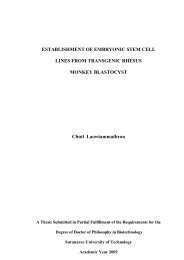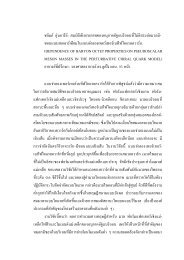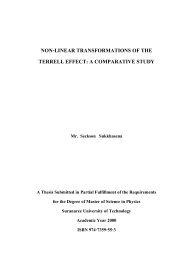PRODUCTION Of NUTRIENT SOURCES FOR RHIZOBIUM
PRODUCTION Of NUTRIENT SOURCES FOR RHIZOBIUM
PRODUCTION Of NUTRIENT SOURCES FOR RHIZOBIUM
Create successful ePaper yourself
Turn your PDF publications into a flip-book with our unique Google optimized e-Paper software.
mannitol, xylitol, and sorbitol were used as standards for the comparison of R f.. The standards gave R f<br />
0.741, 0.464, 0.433, 0.406, and 0.350 for glycerol, xylitol, glucose, mannitol, and sorbitol<br />
respectively, which corresponded to that of authentic sugar alcohols.<br />
In culture broth, 117 isolates produced glycerol could be detected on TLC chromatogram, and<br />
3 isolates could produced high concentration of mannitol on chromatograms. In cell lysate, the<br />
glycerol spot were found slightly from extracts of 2 isolates, and 13 isolates produced mannitol (Table<br />
10). For 15 type strains, the culture broth of Saccharomyces cerevisiae var. burgundi, S. cerevisiae<br />
var. champaign, H. anomala TISTR 5082, K. maxianus TISTR 5270, and S. baryanus showed dense<br />
spots of glycerol on chromatograms. Saccharomyces cerevisiae, C. utilis, C. famata, C. krusei, and C.<br />
tropicalis, and S. fibuligera TISTR 5067 could also produce glycerol detected from their culture broth<br />
(Table 11, Figure 14, 15 and 16). In cell lysate, only Rhodotorula rubra TISTR 5067 produced<br />
mannitol detected on chromatogram (Figure 12 and 13). TLC chromatograms of yeast culture broth<br />
and cell lysates were shown in Figures 12-16. Mannitol was detected from 11 isolates (AFY4, LLY3,<br />
AFY5, SLY1, TAY7, WAY6, KAY1, TAY9, PIY2, PUY4, and Y60) and 1 type strain, R. rubra<br />
TISTR 5067 (Figure 12 and 13). Glycerol was detected 9 isolates (COY1, SWY1, BLY2, APY6,<br />
FAY1, FAY2, LIY2, TAY9 and CIY1) (Figures 14, 15, and 16).<br />
The Glycerol combination test kit was also used for the determination of glycerol in the<br />
screening step. Thirty-three yeast isolates and 1 type strain, K. maxianus TISTR 5270, showed dark<br />
spots on TLC chromatograms were selected for quantitative analysis of glycerol. Nine yeast isolates<br />
with the four scores (Table 10) gave glycerol productivity approximate 1.86-4.64 g/l. The yeast isolate<br />
LIY2 gave the highest glycerol production, 4.64 g/l. The mannitol production was quantified by using<br />
High-Performance Liquid Chromatography (HPLC). Three yeast isolates (KAY1, PIY2, and PUY4)<br />
produced both of mannitol and glycerol in yeast cells and could also produced in cultured medium. At<br />
the three scores, the highest glycerol production were 2.66 g/l and 1.68 g/l respectively from yeast<br />
isolate APY6 and K. maxianus TISTR 5270 (Figure 17).<br />
For the determination of glycerol and mannitol using High-Performance Liquid<br />
Chromatography (HPLC), the sugar alcohols production was compared with the spot on<br />
chromatogram. Yeast isolates KAY1, PIY2, and PUY4, and R. rubra TISTR 5067 could produce<br />
glycerol and mannitol in both cultured media and cell lysates (Table 12). In cultured medium, the<br />
��






